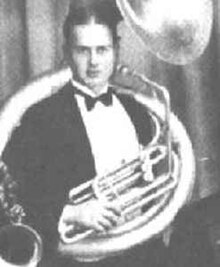
Wilford F. Min Leibrook (January 18, 1903 - June 8, 1943) was an American jazz tubist, bass saxophonist and double bassist. [1]

Wilford F. Min Leibrook (January 18, 1903 - June 8, 1943) was an American jazz tubist, bass saxophonist and double bassist. [1]
Wilford F. (Min) Leibrook was born in Hamilton, Ohio on January 18, 1903. [1] He began as a cornetist before switching to tuba and bass. In the 1920s he played in the Ten Foot Band in Chicago. Leibrook played in The Wolverines in 1924 alongside Bix Beiderbecke, where he made his first recordings, and later joined the band of Arnold Johnson.
In 1927 Leibrook moved to New York City, where he played in the Paul Whiteman Orchestra until 1931. During this time he began recording on bass saxophone, mostly with small jazz groups from the Whiteman band under Beiderbecke and Frankie Trumbauer.
He worked later in the 1930s with Lennie Hayton and Eddie Duchin, mostly on string bass. In 1936 he played in the group The Three T's, with Trumbauer, Jack Teagarden, and Charlie Teagarden.
By the late 1930s, Leibrook moved to Los Angeles and worked as a bassist in Manny Strand’s Band at the Earl Carroll Theater. He never recorded as a leader.
Leibrook died at age 40 as a result of meningitis. He is buried in Forest Lawn Memorial Park, Glendale.
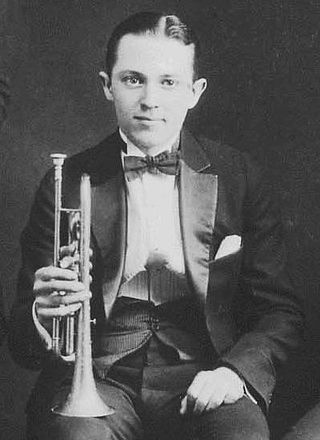
Leon Bismark "Bix" Beiderbecke was an American jazz cornetist, pianist and composer.
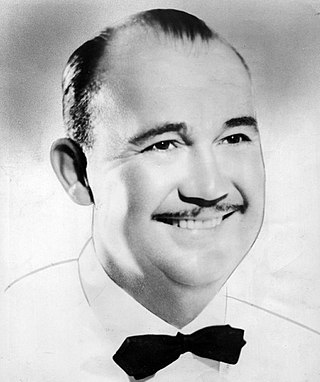
Paul Samuel Whiteman was an American bandleader, composer, orchestral director, and violinist.
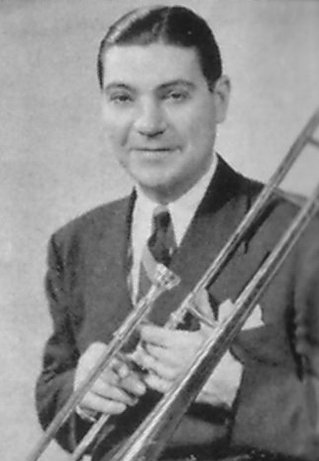
Weldon Leo "Jack" Teagarden was an American jazz trombonist and singer. According to critic Scott Yanow of Allmusic, Teagarden was the preeminent American jazz trombone player before the bebop era of the 1940s and "one of the best jazz singers too". Teagarden's early career was as a sideman with the likes of Paul Whiteman and lifelong friend Louis Armstrong.

Charles Ellsworth "Pee Wee" Russell was an American jazz musician. Early in his career he played clarinet and saxophones, but he eventually focused solely on clarinet.

Giuseppe "Joe" Venuti was an American jazz musician and pioneer jazz violinist.
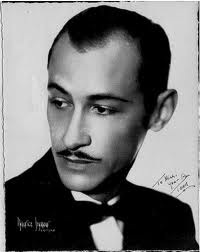
Orie Frank Trumbauer was an American jazz saxophonist of the 1920s and 1930s. His main instrument was the C melody saxophone, a now-uncommon instrument between an alto and tenor saxophone in size and pitch. He also played alto saxophone, bassoon, clarinet and several other instruments.

Adrian Francis Rollini was an American jazz multi-instrumentalist who primarily played the bass saxophone, piano, and vibraphone. Rollini is also known for playing novel instruments such as the goofus, a free-reed instrument resembling a saxophone, and the "hot fountain pen", a sort of keyless miniature clarinet.
Newell "Spiegle" Willcox was a jazz trombonist. He was born Newell Lynn Willcox in upstate New York, and learned valve trombone as a youngster under the tuition of his father, Lynn Willcox, an amateur musician and bandleader. As a student of Manlius Military Academy, where he also played in the school brass band, he acquired the familiar nickname Spiegle, after one of the horses from the Academy's stables which, according to his fellow students, he apparently resembled!

James Dugald "Jimmy" McPartland was an American cornetist. He worked with Eddie Condon, Art Hodes, Gene Krupa, Benny Goodman, Jack Teagarden, and Tommy Dorsey, often leading his own bands. He was married to pianist Marian McPartland.

"Mississippi Mud" is a 1927 song written by Harry Barris, first sung by Bing Crosby as a member of Paul Whiteman's Rhythm Boys. Its musical composition entered the public domain on January 1, 2023.

Carl Kress was an American jazz guitarist.
Joseph Anthony "Fud" Livingston was an American jazz clarinetist, saxophonist, arranger, and composer.

Bix is a 1991 Italian drama film directed by Pupi Avati and starring Bryant Weeks. The plot is about the final years of cornet player Bix Beiderbecke. It was an Official Selection premiering at the 1991 Cannes Film Festival.

"In a Mist" is a 1927 composition for piano by Bix Beiderbecke.
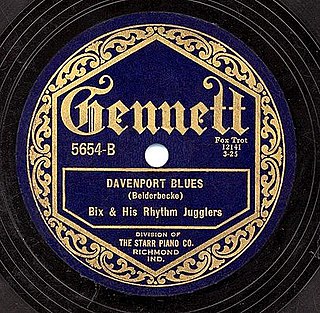
Davenport Blues is a 1925 jazz composition written and recorded by Bix Beiderbecke and released as a Gennett 78. The song has become a jazz and pop standard.
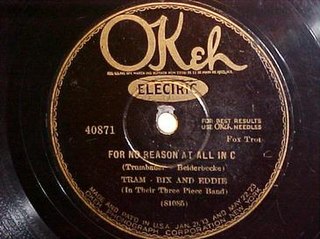
"For No Reason at All in C" is a 1927 jazz instrumental by Bix Beiderbecke, Frankie Trumbauer, and Eddie Lang. It was released as a 78 rpm single in 1927 on OKeh Records as by "Tram, Bix and Eddie ".
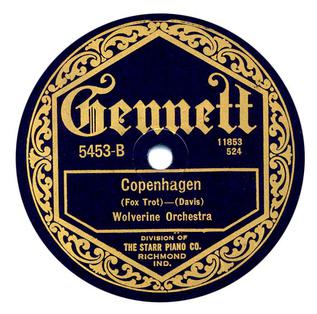
Copenhagen is a jazz standard composed in 1924 by bandleader Charlie Davis and first recorded in that year by the Wolverine Orchestra featuring Bix Beiderbecke in a foxtrot tempo. The title refers to Copenhagen tobacco, favored by Davis's bass player. Lyrics were added by Walter Melrose to the tune, which is a blues in B-flat.
"I'm Coming Virginia" is a song composed in 1926 by Donald Heywood with lyrics by Will Marion Cook. It is often wrongly attributed to vocalist Ethel Waters, who first recorded it on September 18, 1926, with Will Marion Cook's Singing Orchestra. Waters is credited with popularizing it. Cornetist Bix Beiderbecke, pianist Fats Waller and the Paul Whiteman Orchestra featuring Bing Crosby all recorded it in 1927. The song has become a jazz standard performed by Dixieland musicians.

Irving "Izzy" Friedman was an American jazz reedist, best known for playing clarinet on records released by Paul Whiteman and Bix Beiderbecke in the 1920s.
William H. Challis was an American jazz arranger, best known for his association with the Paul Whiteman orchestra.